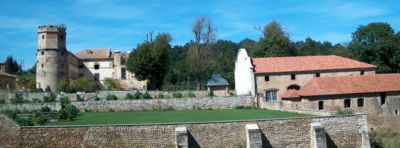
Château de l'Arthaudière
Encyclopedia

Castle
A castle is a type of fortified structure built in Europe and the Middle East during the Middle Ages by European nobility. Scholars debate the scope of the word castle, but usually consider it to be the private fortified residence of a lord or noble...
in the commune of Saint-Bonnet-de-Chavagne
Saint-Bonnet-de-Chavagne
Saint-Bonnet-de-Chavagne is a commune in the Isère department in south-eastern France.- References :*...
in the Isère
Isère
Isère is a department in the Rhône-Alpes region in the east of France named after the river Isère.- History :Isère is one of the original 83 departments created during the French Revolution on March 4, 1790. It was created from part of the former province of Dauphiné...
département of France
France
The French Republic , The French Republic , The French Republic , (commonly known as France , is a unitary semi-presidential republic in Western Europe with several overseas territories and islands located on other continents and in the Indian, Pacific, and Atlantic oceans. Metropolitan France...
. It was the former seigniory of the Arthauds and of the La Porte. The castle is listed as a monument historique
Monument historique
A monument historique is a National Heritage Site of France. It also refers to a state procedure in France by which national heritage protection is extended to a building or a specific part of a building, a collection of buildings, or gardens, bridges, and other structures, because of their...
by the French Ministry of Culture.
History
The oldest part of the castle, the round tower , dates from the 13th century. The keepKeep
A keep is a type of fortified tower built within castles during the Middle Ages by European nobility. Scholars have debated the scope of the word keep, but usually consider it to refer to large towers in castles that were fortified residences, used as a refuge of last resort should the rest of the...
with an oblong plan dates from the 15th century, probably constructed by the Arthaud family.
At the start of the Renaissance
Renaissance
The Renaissance was a cultural movement that spanned roughly the 14th to the 17th century, beginning in Italy in the Late Middle Ages and later spreading to the rest of Europe. The term is also used more loosely to refer to the historical era, but since the changes of the Renaissance were not...
, between the Italian Wars
Italian Wars
The Italian Wars, often referred to as the Great Italian Wars or the Great Wars of Italy and sometimes as the Habsburg–Valois Wars, were a series of conflicts from 1494 to 1559 that involved, at various times, most of the city-states of Italy, the Papal States, most of the major states of Western...
and the Wars of Religion
French Wars of Religion
The French Wars of Religion is the name given to a period of civil infighting and military operations, primarily fought between French Catholics and Protestants . The conflict involved the factional disputes between the aristocratic houses of France, such as the House of Bourbon and House of Guise...
, the castle underwent many drastic alterations. A gallery with an upper floor was built against the western enclosing wall and the tower. At the bottom of the tower a chapel was founded at the beginning of the 16th century. André I de la Porte speaks about it in his will in 1517. At the junction of the Renaissance portico with the northern buildings, a spiral staircase was installed in the 17th century.
Above the chapel, on the first floor, there is a study with an armoured door. This door consists firstly of strongly studded fir
Fir
Firs are a genus of 48–55 species of evergreen conifers in the family Pinaceae. They are found through much of North and Central America, Europe, Asia, and North Africa, occurring in mountains over most of the range...
, together with a cast iron base, the whole to be opened with a single key. This part of the chapel stored the most valuable goods of the Arthauds.
The tower opens to a courtyard through a series of arcades with Italian influences. Italian Renaissance is perhaps the best represented period in the influence of the architecture. The terrace gardens were probably landscaped in the 17th century; today, they serve as a venue for theatre and musical productions.
The grand stables
After the tower, the most prominent external feature of the Château is perhaps the grand stables. Like the castle, the current stables underwent several periods of construction. Their design in the shape of an "L" delimits the first accessible court from the large alley. A passage surmounted by a lantern, intended to transfer fodder to the haylofts upstairs, gives access to another court bordered to the south by the coachman's quarters and a gate leading out. The coach house, the oldest part of the building, today contains a small museum of the history of the castle and the families that lived there.To the right of the entrance to the stable yards, one can see an imperial roof of metal glazed scales set on four octagonal pillars that shelters a stone basin.

